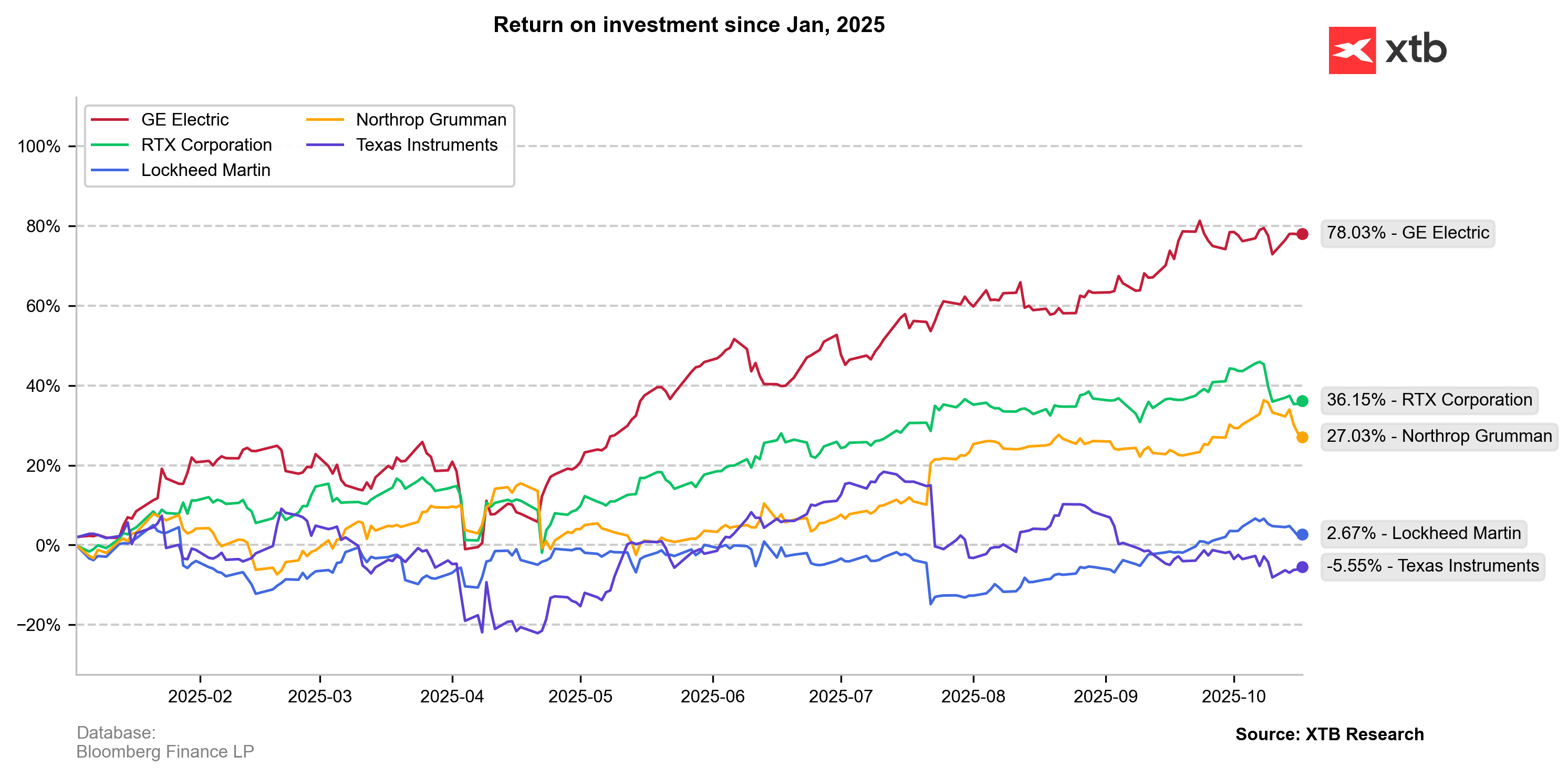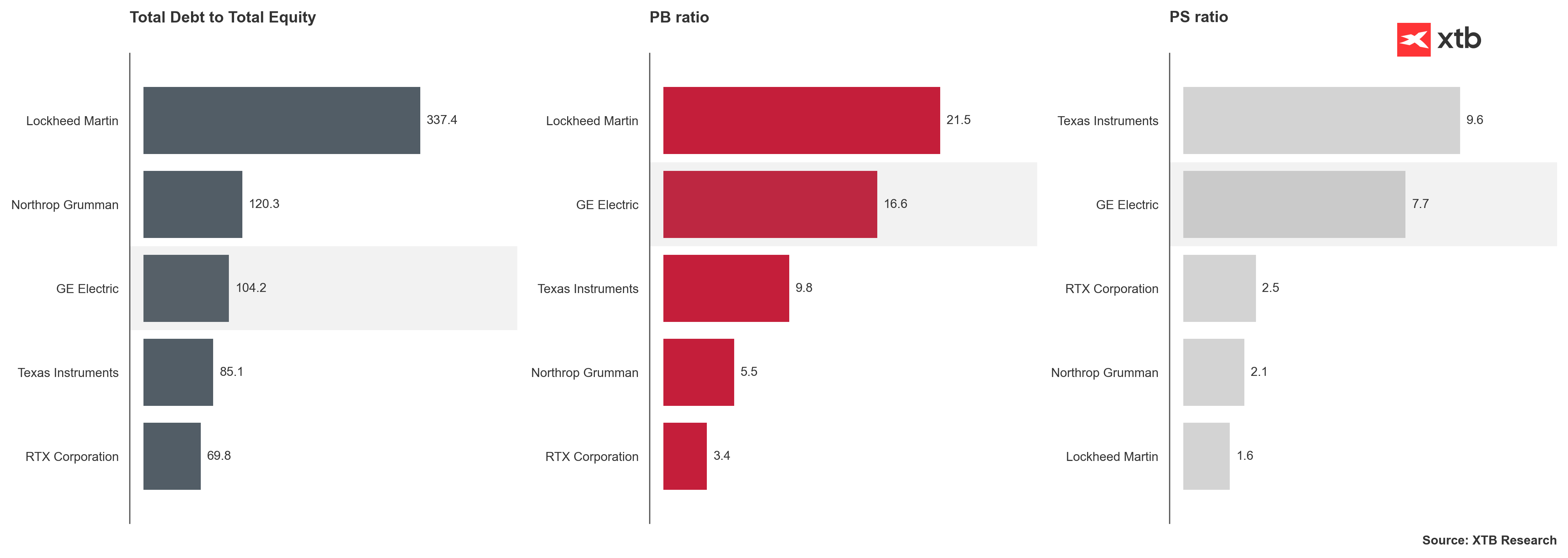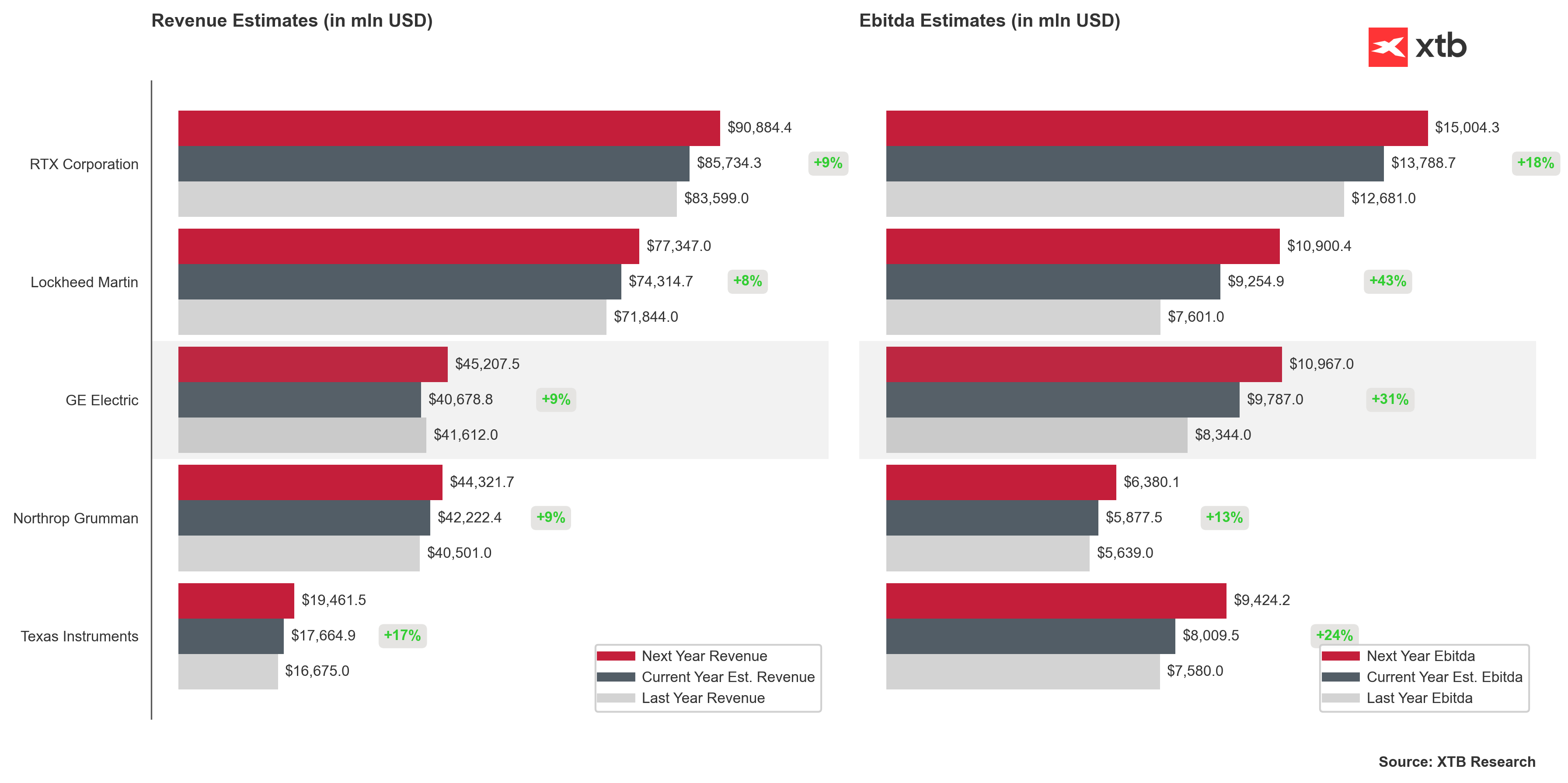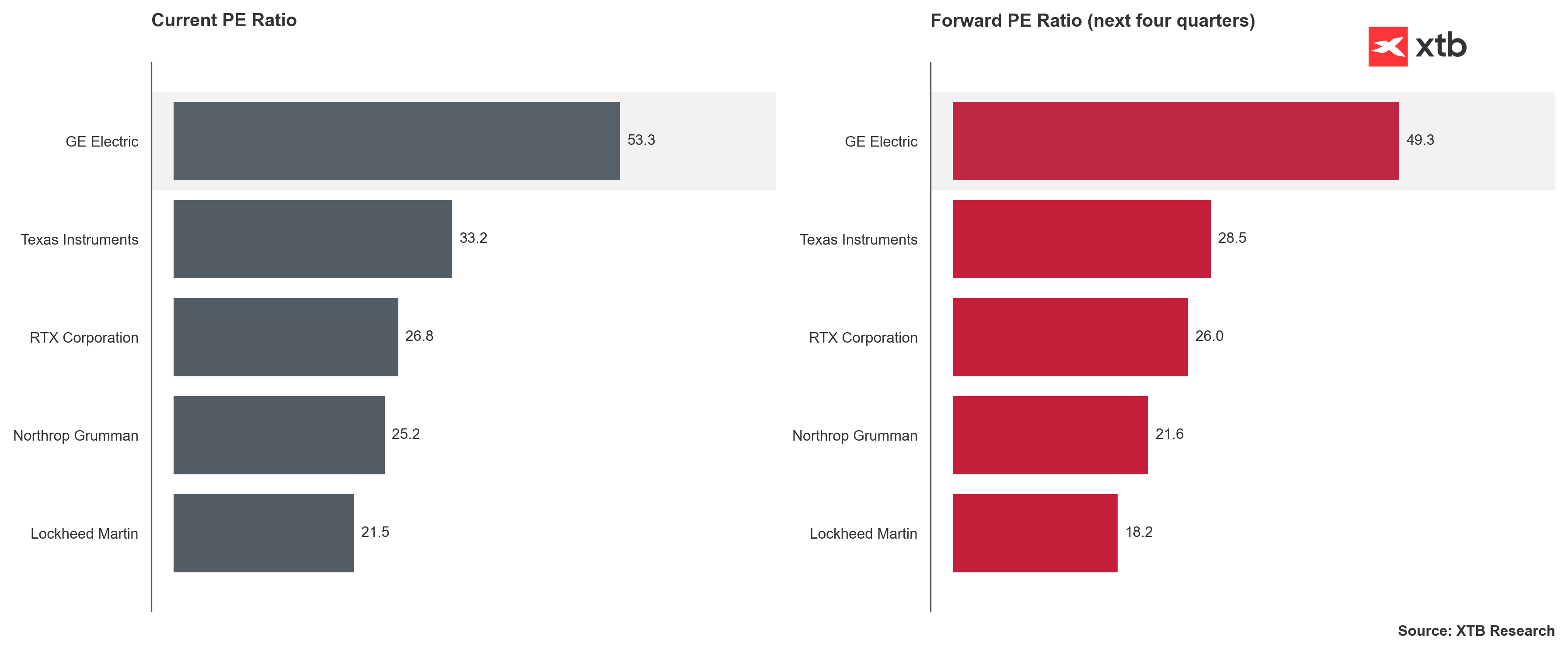- The American defense industry enters another earnings season with record order portfolios but constrained production capacity.
- Global demand remains at a very high level, yet supply chain issues and raw material costs are undermining margins.
- Europe and the Middle East are slowly diversifying their sources of armaments
- Results significantly above or below expectations may signal geopolitical shifts and changes in the fiscal and foreign priorities of the USA.
- The American defense industry enters another earnings season with record order portfolios but constrained production capacity.
- Global demand remains at a very high level, yet supply chain issues and raw material costs are undermining margins.
- Europe and the Middle East are slowly diversifying their sources of armaments
- Results significantly above or below expectations may signal geopolitical shifts and changes in the fiscal and foreign priorities of the USA.
Demand is strong, but not without limitations
The American defense industry sector is still experiencing an exceptional boom, driven by geopolitical events of recent years. Since the outbreak of the war in Ukraine in 2022, the stock prices of companies like Lockheed Martin, Northrop Grumman, RTX, GE Aerospace, and partially Texas Instruments have clearly risen, reflecting a sharp increase in global demand for military equipment. American corporations have not experienced as rapid a rise as their European competitors, but they have maintained very strong financial foundations and record order portfolios.

The operational situation of the companies is good, but not as good as it could be. The market remains in structural imbalance. Demand exceeds supply because the production capacities of many companies are still constrained by supply chain shortages, component shortages, and staffing difficulties. An example is RTX, which has been struggling for months with issues related to the GTF engine installed in Airbus passenger planes. Similar constraints affect GE Aerospace, which, although benefiting from a record number of LEAP engine inspections and services, is still unable to fully meet the demand of airlines and manufacturers.
At the same time, military modernization programs are consuming increasingly larger resources. Lockheed Martin reports a record order portfolio of around $170 billion, RTX over $230 billion, and Northrop Grumman is increasing investments in the development of the B-21 Raider strategic bomber. Demand from NATO countries, the Middle East, and the Indo-Pacific region remains at historically high levels.
GE Aerospace and RTX have a significant share in civilian segments related to commercial aviation, while Texas Instruments is primarily a manufacturer of analog and semiconductor components used in industrial electronics, automotive, and defense systems, but not dependent on military orders. This means that their results do not always directly reflect the condition of the entire defense sector, but rather the overall state of the advanced technology industry in the USA.

Erosion of credibility
Additionally, the political factor cannot be overlooked. The inept and unreliable foreign policy of the United States in recent years, especially during Donald Trump's presidency, has weakened the trust of some allies. Europe is openly discussing the need to become independent of American equipment and build its own defense industry. The European Union has adopted a plan according to which at least half of arms purchases should be made within the Community by the end of the decade.
However, this does not mean a sudden reversal of the trend. In export data, the United States' share in global arms deliveries has increased to over forty percent in recent years. European arms imports have increased by more than half, and most of them still come from the USA. This shows that we are talking about a process of slow but determined diversification, not a sudden and total retreat. It is very likely that this is the last year in which the USA can boast such a large dominance in the sector.
Growing inventories, higher capital, and resource constraints
In the upcoming quarterly reports, it is worth paying attention to changes in balance sheet structures. Companies may show higher inventory levels and growing investment expenditures. This is a consequence of problems with the availability of rare earth metals, which are crucial in the production of engines, radars, and fire control systems. The United States still largely relies on raw materials and components processed in China. The Pentagon is trying to change this state by financing the development of domestic sources and processing plants, but this process requires time and money.
Higher expenditures on inventories and working capital investments may lower current margins and cash flows. In particular, programs implemented at fixed prices, such as the B-21 at Northrop Grumman or some missile contracts, are sensitive to rising material and labor costs.
During earnings conferences, investors will closely monitor not only the numbers but also the language used by CEOs and CFOs. Warning signals may include terms like "capacity issues," "bottlenecks," or "extended delivery cycles." On the other hand, mentions of improved efficiency, increased production capacity, and accelerated order fulfillment will be received positively. It is also worth paying attention to backlog indicators, the ratio of new orders to deliveries, and cash flow conversion.
Will the budget's sacred cow slim down?
In recent months, the topic of rising debt and the tense fiscal situation of the United States has been increasingly returning. Although the defense sector is traditionally considered the "sacred cow" of the American budget, in the long term, even it may feel financial constraints. For now, however, Congress maintains a record level of funding, and the total defense budget for 2026 is expected to exceed $900 billion. If the entire sector's results fall significantly below expectations, it may suggest the first symptoms of fiscal fatigue and the progressing isolation of the United States on the international stage. If this scenario is to unfold, forecasts for sales in the coming quarters will be as important, if not more so, than the results.
The opposite scenario, i.e., results significantly above forecasts, could mean more than just a long-awaited improvement in efficiency. If American defense companies start reporting a sharp increase in sales and investments, shortened delivery cycles, expansion of ammunition production capacity, and aviation, it may be a signal that the country is preparing for increased military activity. Such a picture could indicate preparations for potential intervention or kinetic confrontation.


The American defense industry remains in excellent condition despite the increasingly concerning state of American finances and the economy. However, it operates at the edge of its maximum capabilities. Record order portfolios, resource shortages, and strained supply chains create a mix where revenues grow on paper, but margins remain under pressure.
The market still trusts the determination of the USA to pour endless streams of money into its military, but it increasingly sees the inefficiency of the American industry and political system. The upcoming results will show whether American corporations can turn demand into sustainable profit and growth or whether they will get stuck in the trap of inefficient supply chains, unstable budgets, and management without prospects.
DE40: Regulatory and diplomatic escalations amid holidays
BREAKING: BoE cuts interest rates. GBPUSD rebounds
DE40: Many informations, few movements
⏫Oil rallies 2% on Supply Uncertainty
The content of this report has been created by XTB S.A., with its registered office in Warsaw, at Prosta 67, 00-838 Warsaw, Poland, (KRS number 0000217580) and supervised by Polish Supervision Authority ( No. DDM-M-4021-57-1/2005). This material is a marketing communication within the meaning of Art. 24 (3) of Directive 2014/65/EU of the European Parliament and of the Council of 15 May 2014 on markets in financial instruments and amending Directive 2002/92/EC and Directive 2011/61/EU (MiFID II). Marketing communication is not an investment recommendation or information recommending or suggesting an investment strategy within the meaning of Regulation (EU) No 596/2014 of the European Parliament and of the Council of 16 April 2014 on market abuse (market abuse regulation) and repealing Directive 2003/6/EC of the European Parliament and of the Council and Commission Directives 2003/124/EC, 2003/125/EC and 2004/72/EC and Commission Delegated Regulation (EU) 2016/958 of 9 March 2016 supplementing Regulation (EU) No 596/2014 of the European Parliament and of the Council with regard to regulatory technical standards for the technical arrangements for objective presentation of investment recommendations or other information recommending or suggesting an investment strategy and for disclosure of particular interests or indications of conflicts of interest or any other advice, including in the area of investment advisory, within the meaning of the Trading in Financial Instruments Act of 29 July 2005 (i.e. Journal of Laws 2019, item 875, as amended). The marketing communication is prepared with the highest diligence, objectivity, presents the facts known to the author on the date of preparation and is devoid of any evaluation elements. The marketing communication is prepared without considering the client’s needs, his individual financial situation and does not present any investment strategy in any way. The marketing communication does not constitute an offer of sale, offering, subscription, invitation to purchase, advertisement or promotion of any financial instruments. XTB S.A. is not liable for any client’s actions or omissions, in particular for the acquisition or disposal of financial instruments, undertaken on the basis of the information contained in this marketing communication. In the event that the marketing communication contains any information about any results regarding the financial instruments indicated therein, these do not constitute any guarantee or forecast regarding the future results.


